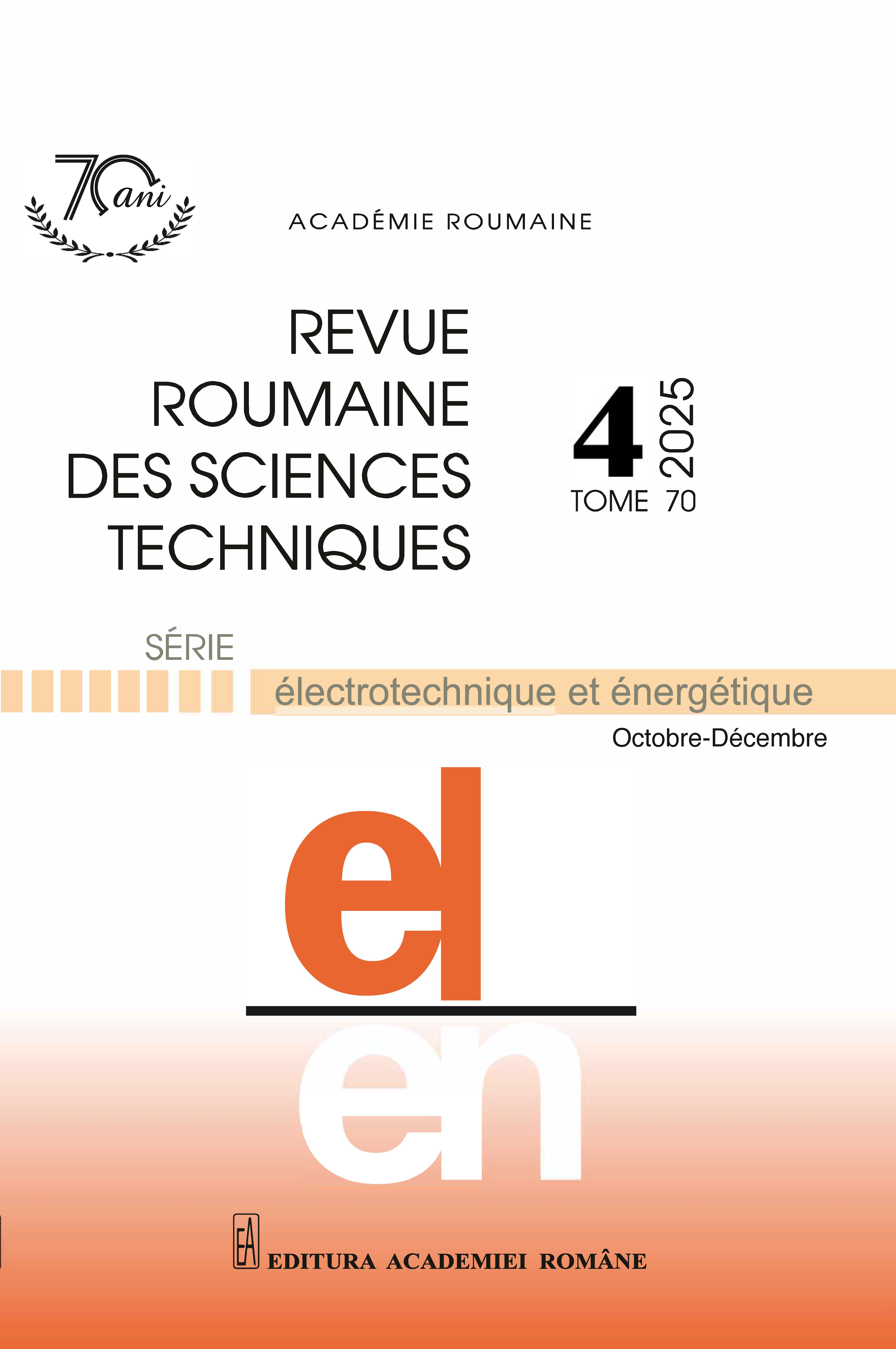ANALYSE HARMONIQUE DES SOURCES D'ÉNERGIE DISTRIBUÉES À L'AIDE DE LA FFT GLISSANTE ET DE LA NORME CEI 61000-4-7
DOI :
https://doi.org/10.59277/RRST-EE.2025.4.13Mots-clés :
EN 50160, Transformée de Fourier rapide (FFT), Harmoniques, Centrale hydroélectrique, IEEE 519, Centrale photovoltaïque (PV)Résumé
Cet article présente les résultats de l'analyse harmonique des signaux de courant et de tension mesurés aux points de couplage commun (PCC) aux réseaux de distribution de plusieurs sources d'énergie distribuées. Une petite centrale hydroélectrique (HPP) et quatre petites centrales photovoltaïques (PV) sont prises en compte. Les harmoniques de tension et de courant sont calculées de deux manières : 1) conformément à la norme CEI 61000-4-7, et conformément aux normes IEEE 519 et EN 50160, et 2) par transformation de Fourier rapide glissante (SFFT), qui est appliquée pour calculer les harmoniques de courant et de tension variables dans le temps dans les signaux enregistrés spécifiques. L'application des normes IEEE 519 et EN 50160 donne des résultats et des conclusions différents en raison des procédures de calcul et des valeurs limites différentes. Les centrales photovoltaïques peuvent générer des courants presque sinusoïdaux lorsqu'elles fonctionnent à haute puissance, tandis que les centrales hydroélectriques peuvent générer des courants à formes d'onde fortement déformées lorsqu'elles alimentent de grandes charges non linéaires. En conséquence, les quatre centrales photovoltaïques répondent aux exigences en matière d'harmoniques de courant et de tension, tandis que la centrale hydroélectrique analysée ne respecte pas certaines des limites définies. L'analyse SFFT confirme la faisabilité d'une surveillance dynamique des harmoniques en temps réel, susceptible de jouer un rôle crucial dans les réseaux de distribution modernes.
Références
(1) V.G. Dogaru, F.D. Dogaru, V. Navrapescu, and L.M. Constantinescu, From the photovoltaic effect to a low voltage photovoltaic grid challenge–a review, Rev. Roum. Sci. Techn. – Électrotechn. et Énerg., 69, 3, pp. 263–268 (2024).
(2) R. Elumalai, Maximum power quality tracking of artificial neural network controller-based double-fed induction generator for wind energy conversion system, Rev. Roum. Sci. Techn. – Électrotechn. et Énerg., 69, 2, pp. 189–194 (2024).
(3) M. Milovanović, J. Radosavljević, B. Perović, J. Vukašinović, A. Jovanović, and M. Banjanin, Point-estimate method for probabilistic power flow in unbalanced and distorted distribution systems, In IEEE 23rd International Symposium Infoteh-Jahorina (INFOTEH), pp. 1–6 (2024).
(4) ***Study Committee C4, Work Group C4.112, Guidelines for power quality monitoring– measurement locations, processing and presentation of data, CIGRE/CIRED Technical brochures 596 (2014).
(5) ***Voltage characteristics of electricity supplied by public electricity networks, EN 50160:2010 (2010).
(6) ***IEEE Standard for Harmonic Control in Electric Power Systems, IEEE Std 519-2022 (2022).
(7) Carretero-Hernandez, E. Artigao, S. Martin-Martinez, C. Alvarez-Ortega, M. Ochoa-Gimenez, and E. Gomez-Lazaro, Comparison of harmonic emission in LV side of a large grid-connected PV power plant, Electric Power Systems Research, 223, 109586 (2023).
(8) R.K. Varma, S.A. Rahman, T. Vanderheide, and M.D.N. Dang, Harmonic impact of a 20-MW PV solar farm on a utility distribution network, IEEE Power and Energy Technology Systems Journal, 3, 3, pp. 89–98 (2016).
(9) M. Ikić and J. Mikulović, Experimental evaluation of distortion effect for grid-connected PV systems concerning different types of electric power quantities, Energies, 15, 2, 416 (2022).
(10) E. Melić, A. Bosović, and M. Musić, Analysis of the impact of different distributed generator technologies on harmonic voltages, Rev. Roum. Sci. Techn. – Électrotechn. et Énerg., 68, 2, pp. 146–151 (2023).
(11) L.F. Pak, V. Dinavahi, G. Chang, M. Steurer, and P.F. Ribeiro, Real-Time Digital time-varying harmonic modeling and simulation techniques, IEEE task force on harmonics modeling and simulation, IEEE Transactions on Power Delivery, 22, 2, pp. 1218–1227 (2007).
(12) M. Banjanin and M. Ikić, Measurement and analysis of the electric power quality parameters at the point of connection of PV plant Brankovići 1 and PV plant Brankovići 3 to the electrical distribution network, 22nd International Symposium INFOTEH-JAHORINA, pp. 197–202 (2023).
(13) M. Banjanin, M. Ikić, M. Timotija, S. Makljenović, and L. Gluhović, Measurement and analysis of the electric power quality parameters at the point of connection of MHE Miljacka to the 10 kV electrical distribution network, 22nd International Symposium INFOTEH-JAHORINA, pp. 191–196 (2023).
(14) ***Electromagnetic compatibility (EMC) – Part 4-7: Testing and measurement techniques – General guide on harmonics and interharmonics measurements and instrumentation, for power supply systems and equipment connected thereto, IEC 61000-4-7:2002+AMD1:2008 CSV, Edition 2.1 (2009).
(15) ***PQA, Metrel (2024).
(16) M. Banjanin, M. Milovanović, and J. Radosavljević, Voltage dips and swells detection by sliding fast Fourier transform: Possibilities for application in modern distribution networks, Journal of Electrical Engineering, 76, 1, pp. 58–71 (2025).
Téléchargements
Publiée
Numéro
Rubrique
Licence
(c) Copyright REVUE ROUMAINE DES SCIENCES TECHNIQUES — SÉRIE ÉLECTROTECHNIQUE ET ÉNERGÉTIQUE 2025

Ce travail est disponible sous licence Creative Commons Attribution - Pas d'Utilisation Commerciale - Pas de Modification 4.0 International.


